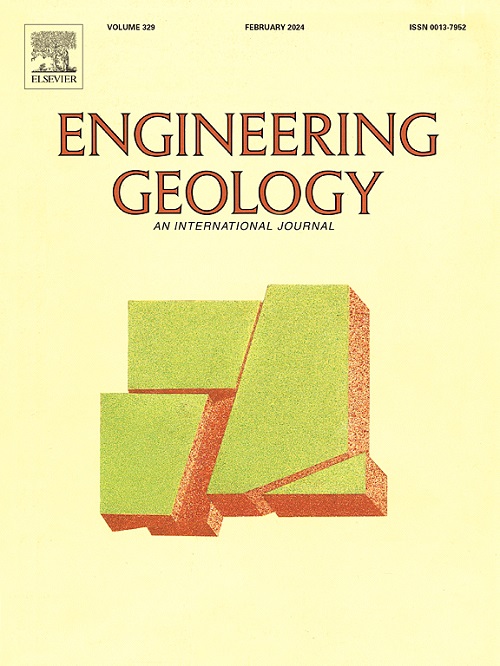Shaking table tests on the effect of transverse rib thickness on the stability of geosynthetic-reinforced soil walls
IF 8.4
1区 工程技术
Q1 ENGINEERING, GEOLOGICAL
引用次数: 0
Abstract
Geosynthetic-reinforced soil (GRS) structures are extensively employed in infrastructure for mitigating geological disasters and facilitating restoration. Despite their widespread use, the seismic design of GRS structures requires further refinement. This study investigates the potential of three-dimensional modifications to geosynthetics for enhancing geosynthetic–soil interaction strength, extending shear bands range and reducing reinforcement length, backfill volume, and construction costs. Shaking table tests were conducted to evaluate the dynamic response of planar and stereoscopic geogrid-reinforced soil retaining walls. Using the Hilbert-Huang transform, time–frequency domain analysis examined the effects of varying transverse rib thickness, reinforcement spacing, and reinforcement length on acceleration response, panel displacement, settlement, geogrid strain, and spectrum amplitude evolution. The results reveal that stereoscopic geogrids with thickened transverse ribs improve the dynamic stability of GRS walls. Both wall types exhibited a combination failure mode involving arc-shaped and sliding failure mechanisms under increased spacing or reduced reinforcement length, but transverse rib thickness had a particularly significant effect on structural performance and deformation behavior. The failure surface in the backfill was visually observed using marked sand tracking, which showed that thickened transverse ribs reduced the dislocation height difference of soil markers by 60 %. In contrast, planar geogrids experienced a 39.8 % increase in average strain increment, greater horizontal panel displacement, and more pronounced sliding failure. During vibration, stereoscopic geogrid reinforcement reduced the increase in high-frequency amplitude propagation from the base to the top of the model, lowering it from 83.0 % to 16.1 %. These findings provide valuable insights for optimizing seismic design parameters in GRS walls, contributing to improved dynamic stability and cost efficiency.
振动台试验研究了横肋厚度对土工合成土墙稳定性的影响
土工合成加筋土(GRS)结构广泛应用于减轻地质灾害和促进恢复的基础设施中。尽管GRS结构被广泛使用,但其抗震设计仍需进一步改进。本研究探讨了对土工合成材料进行三维改性的潜力,以提高土工合成材料与土壤的相互作用强度,延长剪切带范围,减少钢筋长度,回填体积和施工成本。通过振动台试验对平面和立体土工格栅挡土墙的动力响应进行了评价。利用Hilbert-Huang变换,时频域分析考察了不同横肋厚度、配筋间距和配筋长度对加速响应、面板位移、沉降、土工格栅应变和频谱振幅演变的影响。结果表明,加厚横向肋的立体土工格栅提高了墙体的动力稳定性。增大配筋间距或减小配筋长度时,两种墙体均表现出弧形和滑动破坏的组合破坏模式,但横肋厚度对结构性能和变形行为的影响尤为显著。采用标记砂跟踪法对充填体破坏面进行了目视观察,结果表明,加厚的横肋使土体标记物的错位高度差减小了60%。相比之下,平面土工格栅的平均应变增量增加了39.8%,水平板位移更大,滑动破坏更明显。振动过程中,立体土工格栅加固降低了模型底部至顶部高频振幅传播的增幅,从83.0%降至16.1%。这些发现为优化GRS墙体的抗震设计参数提供了有价值的见解,有助于提高动态稳定性和成本效率。
本文章由计算机程序翻译,如有差异,请以英文原文为准。
求助全文
约1分钟内获得全文
求助全文
来源期刊

Engineering Geology
地学-地球科学综合
CiteScore
13.70
自引率
12.20%
发文量
327
审稿时长
5.6 months
期刊介绍:
Engineering Geology, an international interdisciplinary journal, serves as a bridge between earth sciences and engineering, focusing on geological and geotechnical engineering. It welcomes studies with relevance to engineering, environmental concerns, and safety, catering to engineering geologists with backgrounds in geology or civil/mining engineering. Topics include applied geomorphology, structural geology, geophysics, geochemistry, environmental geology, hydrogeology, land use planning, natural hazards, remote sensing, soil and rock mechanics, and applied geotechnical engineering. The journal provides a platform for research at the intersection of geology and engineering disciplines.
 求助内容:
求助内容: 应助结果提醒方式:
应助结果提醒方式:


